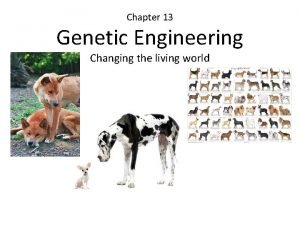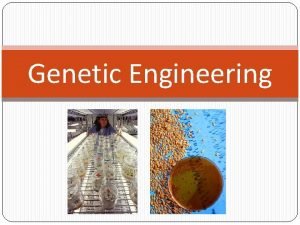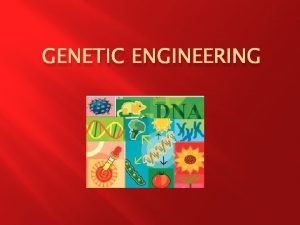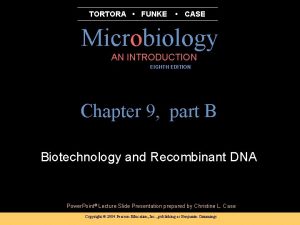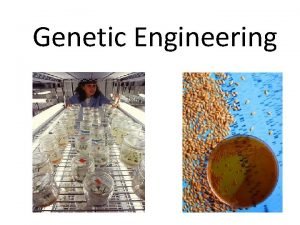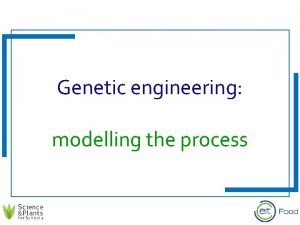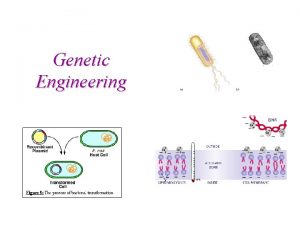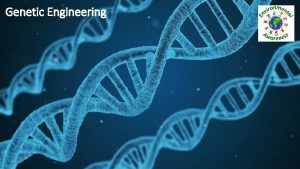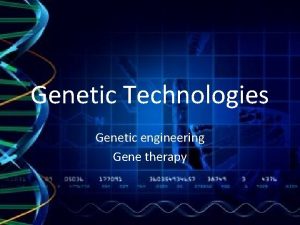Applications of Genetic Engineering The applications of Genetic





















- Slides: 21

Applications of Genetic Engineering

The applications of Genetic Engineering 1. Pharmaceutical use, to treat human disorders. -Diabetes: Condition where people cannot make Cut the gene out of humans and put it into bacteria. The bacteria can make human insulin using this gene and the insulation can be collected to give to people with diabetes. **Bacteria can make human insulin. **This prevented many diabetics from getting an allergic reaction to animal insulin.

Production of humalin Used by diabetics 3

The applications of Genetic Engineering 1. Pharmaceutical use -Recombinant bacteria are used in the production of human growth hormone to treat pituitary Dwarfism. -Bacteria make interferon which can fight virus infections and some cancers. -Hemophilia : use transgenic pig to make missing clotting factor.

Vaccines • Vaccine : a harmless form of the pathogen. Made from recombinant DNA. Tells your body what a specific pathogen looks like – if your body knows what it looks like it can fight it. • Genetically engineered microbes can be used to produce the antigens needed in a safe and controllable way. • The use of genetically modified yeast cells to produce a vaccine against the hepatitis B virus has been a major success story.

Gene Therapy – Gene Therapy: is the insertion of normal genes into human cells to correct genetic disorders. – In gene therapy, an absent or faulty gene is replaced by a normal, working gene. – This process allows the body to make the protein or enzyme it needs, which eliminates the cause of the disorder. – The idea of gene therapy is to overcome the effects of a mutation which causes a genetic disease.

One Example of Gene Therapy – To deliver therapeutic genes to target cells researchers engineer a virus that cannot reproduce or cause harm. – The DNA containing therapeutic gene is inserted into the modified virus. – The patient’s cells are then infected with the genetically engineered virus. – In theory the virus will insert the healthy gene into the target cell and correct the defect.

Gene Therapy is in the trial stages (i. e. they are testing it out) Used first with cystic fibrosis. How does gene therapy work? -Put the normal gene (the one that makes the normal transport protein) in a cold virus. -Introduce the virus to the lungs (the organ manly affected by cystic fibrosis) using a nasal spray. Hope that the lung cells take up the normal gene into their chromosomes and make up normal protein.



– Drawback of Gene Therapy = the genes do not always stay active for long periods of time. – Gene therapy can be risky. – In 1999, 18 -year-old Jesse Gelsinger volunteered for a gene therapy experiment designed to treat a genetic disorder of his liver. He suffered a massive reaction from the viruses used to carry genes into his liver cells, and he died a few days later. – For gene therapy to become an accepted treatment, we need more reliable ways to insert working genes and to ensure that the DNA used in therapy does no harm.

2 -Agriculture and Industry – Almost everything we eat and much of what we wear come from living organisms. – Researchers have used genetic engineering to try to improve the products we get from plants and animals. – Genetic modification could lead to better, less expensive, and more nutritious food as well as less harmful manufacturing processes.

Agriculture Genetically modified (GM) Crops – Since their introduction in 1996, genetically modified (GM) plants have become an important component of our food supply. – One genetic modification uses bacterial genes that produce a protein known as Bt toxin. – This toxin is harmless to humans and most other animals, but enzymes in the digestive systems of insects convert Bt to a form that kills the insects. – Plants that are resistant to frost damage(Corn, broccoli, potatoes and cotton have been developed to produce BT toxin from bacterial gene, which makes them resistant to certain pests.

– Plants with the Bt gene do not have to be sprayed with pesticides. – In addition, they produce higher yields of crops. – Various plants have been made resistant to herbicides used to rid fields of unwanted weeds. – Canola plants have been modified so they make a higher yield of oil. – Crops that are better tasting, stay fresher longer, and are protected from disease and insect manifestations.

Genetically modified Animals – Transgenic animals are becoming more important to our food supply. – About 30 percent of the milk in U. S. markets comes from cows that have been injected with hormones made by recombinant-DNA techniques to increase milk production. – Pigs can be genetically modified to produce more lean meat or high levels of healthy omega-3 acids. – Using growth-hormone genes, scientists have developed transgenic salmon that grow much more quickly than wild salmon. – Scientists are working to combine a gene for lysozyme ; an antibacterial protein found in human tears and breast milk into the DNA of goats. Milk from these goats may help prevent infections in young children who drink it.

Preventing Disease by transgenic plants and animals – Golden rice is a GM plant that contains increased amounts of provitamin A, also known as betacarotene—a nutrient that is essential for human health. Two genes engineered into the rice genome help the grains produce and accumulate betacarotene. Provitamin A deficiencies produce serious medical problems, including infant blindness. There is hope that provitamin A–rich golden rice will help prevent these problems. – Other scientists are developing transgenic plants and animals that produce human antibodies to fight disease.

Plant Application Golden Rice – a possible solution to Vitamin A deficiency. 17

Industry – Create bacteria that can break down oil from oil spills faster than normal bacteria. They are the first patented organisms. – Scientists have modified the bacterium E. coli to produce expensive indigo dye that is used to color blue genes. – Production of cheese, laundry detergent, pulp and paper products, and sewage treatment. – High protein corn with protein levels similar to beef. Automobile fuel from discarded corn stalks.

3 -Personal Identification – In DNA fingerprinting, restriction enzymes first cut a small sample of human DNA into fragments containing genes and repeats. Note that the repeat fragments from these two samples are of different lengths. – Next, gel electrophoresis separates the restriction fragments by size. – DNA samples can be obtained from blood, sperm, or tissue—even from a hair strand if it has tissue at the root.

Forensic Science • The precision and reliability of DNA fingerprinting has revolutionized forensics—the scientific study of crime scene evidence. • DNA fingerprinting has helped solve crimes, convict criminals, and even overturn wrongful convictions. • To date, DNA evidence has saved more than 110 wrongfully convicted prisoners from death sentences.

4 -Diagnostic Tests – Genetic engineering can produce very specific and sensitive diagnostic tests for many diseases, using engineered proteins. – This new technology is also opening up novel ways of delivering medicines to specific targets.
 Genetic engineering
Genetic engineering Section 13-2 manipulating dna
Section 13-2 manipulating dna What is the difference between genetic drift and gene flow
What is the difference between genetic drift and gene flow Genetic programming vs genetic algorithm
Genetic programming vs genetic algorithm Genetic programming vs genetic algorithm
Genetic programming vs genetic algorithm Genetic drift
Genetic drift What is the difference between genetic drift and gene flow
What is the difference between genetic drift and gene flow Production of insulin
Production of insulin Section 13-1 changing the living world
Section 13-1 changing the living world Cloning tasmanian tiger
Cloning tasmanian tiger Purpose of genetic engineering
Purpose of genetic engineering Genetic engineering conclusion
Genetic engineering conclusion Oryx and crake genetic engineering
Oryx and crake genetic engineering Genetic modification pros and cons in humans
Genetic modification pros and cons in humans Ethical issues of genetic engineering
Ethical issues of genetic engineering Bioluminescence genetic engineering
Bioluminescence genetic engineering Objectives of genetic engineering for class 10
Objectives of genetic engineering for class 10 Agrobacterium tumefaciens genetic engineering
Agrobacterium tumefaciens genetic engineering Genetic engineering
Genetic engineering Algenol
Algenol Cry gene
Cry gene Genetic engineering
Genetic engineering








